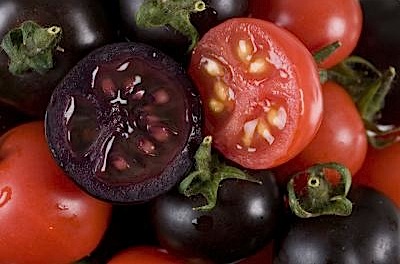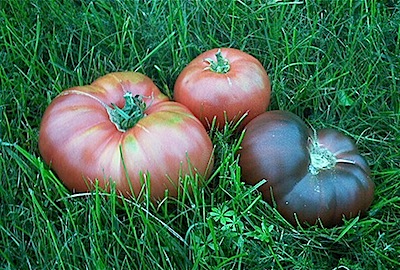
I was going to do an in-depth analysis of a paper in tonight’s Nature Biotechnology, but it’s been a busy weekend and there are two press releases out there that do enough of a job on it for my purposes. From one:
Scientists have expressed genes from snapdragon in tomatoes to grow purple tomatoes high in health-protecting anthocyanins. … The scientists tested whether these elevated levels actually had an effect on health. In a pilot test, the lifespan of cancer-susceptible mice was significantly extended when their diet was supplemented with the purple tomatoes compared to supplementation with normal red tomatoes.
Mice given 10% of their diet in the form of powdered, freeze-dried purple tomato lived an average of 182 days, compared to 142 days for mice fed the same amount of freeze-dried red tomato or no supplement, which did not differ from one another. That’s great. Proof of concept, if you like.
From the other:
“The study” says Cathie Martin, FLORA project coordinator “confirms the latest research trends arguing that we can obtain significant beneficial effects by simple changes in our daily diet. We are not talking of pills or supplements but only food. It is worthy of notice that recommendations by worldwide governments risk to be unaccepted. The 5-a-day program promoted by the American National Cancer Institute 20 years ago does not seem to be very incisive and not just because of the lack of time. Financial crisis is giving an hand to the failure of good intentions mainly due to the expensive costs of fruits and vegetables. Research has to do something, has to find new ways to face the challenge. A solution may rely on concentrating in few but selected products the largest part of nutrients we should intake during the whole day”. 1
Researchers are clearly working hard to put anthocyanin genes into tomatoes, hoping, I suppose, that eventually people will eat those, or freeze-dried anthocyanin-rich genetically-engineered tomato powder, to ward off cancer. I wonder though, why they didn’t start with a naturally purple tomato and attempt to up-regulate the purple pigment genes. Too difficult? There are many such varieties, and I happen to be sensitized to them right now because in connection with something else I came across the Organic Seed Project, which lists “Improvement of Prudens Purple Tomato” as one of its Participatory Plant Breeding projects. Alas, that’s all it does. List it. Anyone know more?

The top photograph, from the research scientists, shows their very purple engineered tomato. The lower one, which has a very bluish cast, suggesting an excess of Photoshopping zeal, shows Prudens Purple in the centre and Black from Tula, a Russian variety, on the right. I’m not aware of any thorough measurements of anthocyanins in tomato varieties, though there is a wild relative with a gene that produces anthocyanin fruit. What is more, it has been conventionally-bred into domesticated tomatoes. We blogged it almost two years ago. 2 I wonder why we have heard no more about it.
My point is not that there’s anything wrong with genetically engineered purple tomatoes. It is that lots of people may think there is. Indeed, and I know I’m going out on a limb here, such a belief may even be more common among those who are most likely to eat food-based dietary supplements to promote good health. So if researchers really want people to eat their tomatoes, why engineer them?
- I think this may have been babelfished a couple of times, but that’s not my responsibility.
- Although the link that points to is dead and gone.
If you look a bit further on the web site, they DO describe the Improved Prudens Purple Tomato project, and it looks as if you can get seed.
@Mike Huben –
Thanks Mike. I thought I had explored that site (which makes me feel like an internet Rip van Winkle) fully, but obviously I was wrong. Too bad that “no generation advancement was made in the tomato breeding program at Highmoor Farm in 2007 due heavy browsing by deer”. I expect the same would have been true under non-organic conditions. :)
Maybe I’m being naive but it makes no sense to me at all. Why use expensive patented technology to create something which could have been bred conventionally? And if a diet rich in anthocyanin is so beneficial, why not just encourage people to eat more blueberries? Am I missing something?
What concerns me is the way this is being reported in the mainstream media, where the “story” is that these GM tomatoes are providing a new and unique health benefit. Most people don’t know enough about it to realise that the beneficial pigment is widely available in other fruits, and the suggestion is that this is somehow a breakthrough which was only made possible by genetic engineering. Cynical marketing, I call it.
I have to go somewhere right now so I can’t read much in depth about this post and respond at length, this looks like a great news find. But I will suggest something I’ve said before elsewhere and will say again. We are heading for a cultural collision on GE crops. The very people who are the most opposed to them for whatever reason are going to find more and more of them that specifically appeal to what they’re looking for in foods. ‘Hmmm… I want more antioxidants… and this GE tomato has more of them… but it’s GE… but it has antioxidants…’
Or, as Rebsie pointed out minutes before you, “I think I’ll eat a punnet of blueberries instead”. :)
But you’re right too. Pamela Ronald’s discussion of sweetcorn engineered to kill earworms is a good example. People don’t like earworms, and they don’t like pesticides, so they need to make a choice that can make weak minds explode with the effort.
Not everyone can afford to eat blueberries regularly, and not everyone likes ’em too. (My spouse being one) That begs the question about how expensive these tomatoes might be when/if they hit the market. I think it is also worthy to note that this was not done at a seed company but at an independent research institute funded by the EU and the BBSRC – public institutions.
As Jeremy says, there’s nothing intrinscally wrong with genetic engineering. It can let you do things you can’t do with standard plant breeding: for example, the anthocyanins in the GE tomatoes pictured might be different anthocyanins from the ones in the heirloom varieties or the interspecies hybrids. Or they may be produced in different quantities: that looks like a very high level, much higher than in the heirlooms. Or in different parts of the fruit (skin versus flesh versus gel.)
The problem with GE is that there are no standards yet concerning the risks of unintended effects. Even with conventional breeding, you can get unintended effects due to wild-type toxins in various food plants. But GE offers additional risks, such as allergens from genetic sources (in this case snapdragons) that aren’t in normal foods. I think it is entirely proper to have some sort of risk management to prevent our traditional knowledge of food risks from careless subversion. In other words, regulatory standards that must be met for non-allergenicity, non-toxicity, and other potential problems based on the introduction of new gene products into our food systems. Just like we want regulatory clearance of food additives, artifical sweeteners, and other synthetic introductions to our food systems.